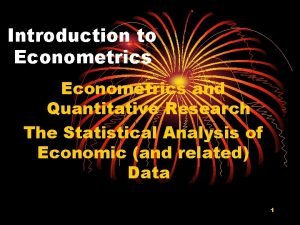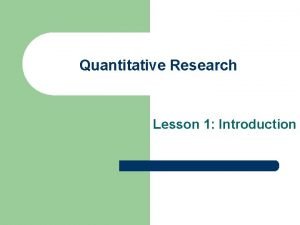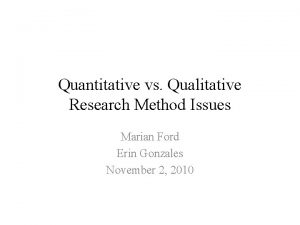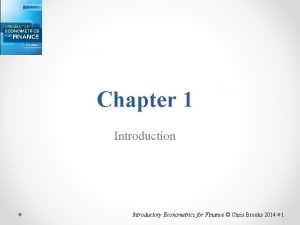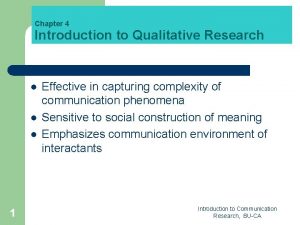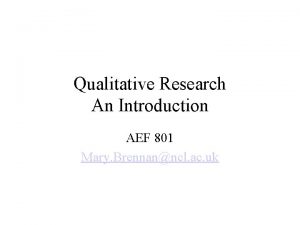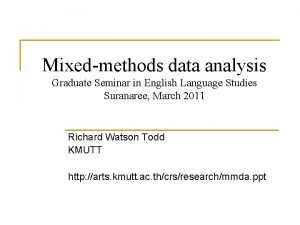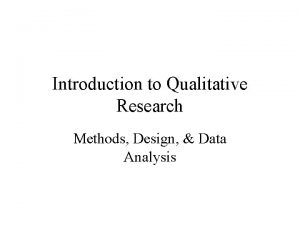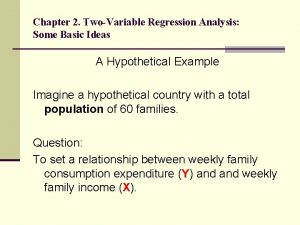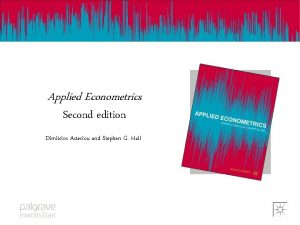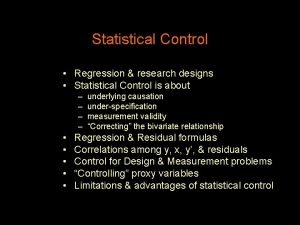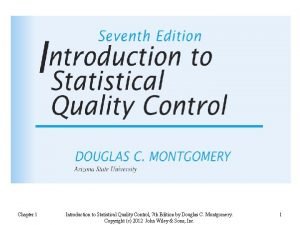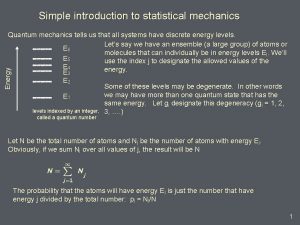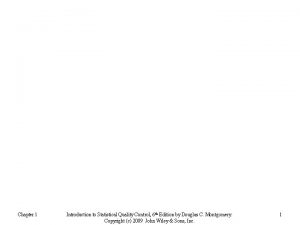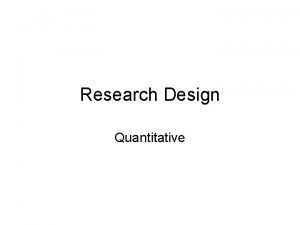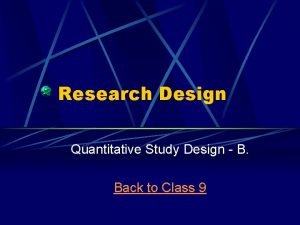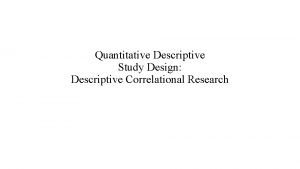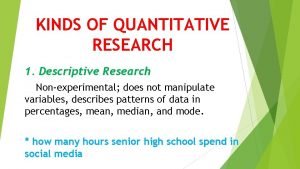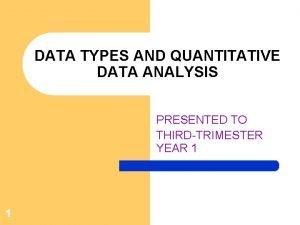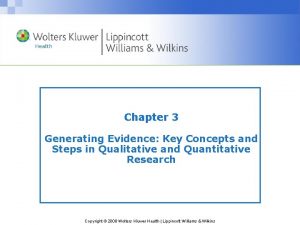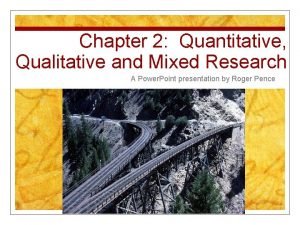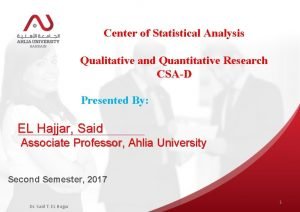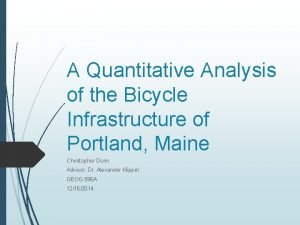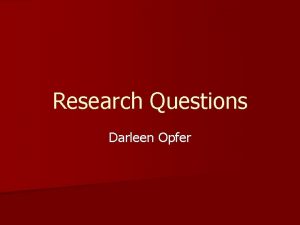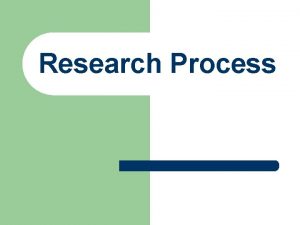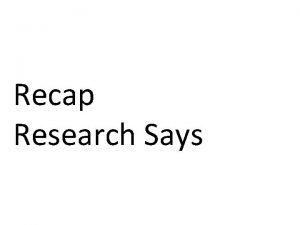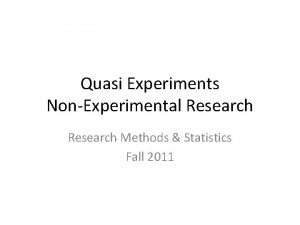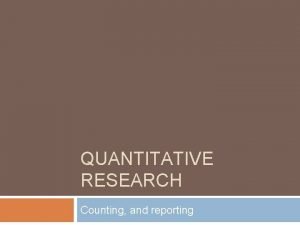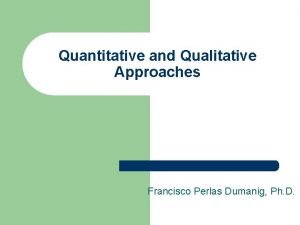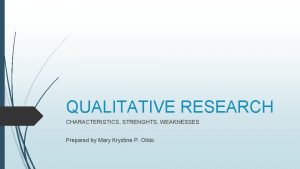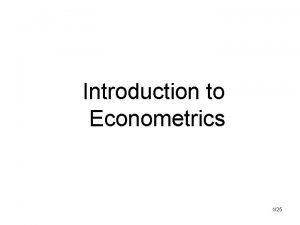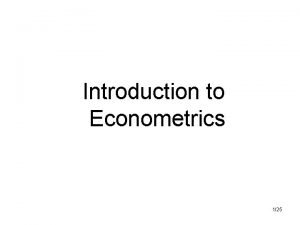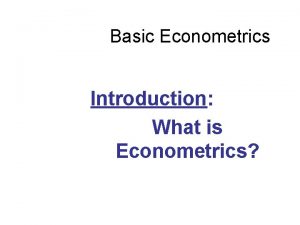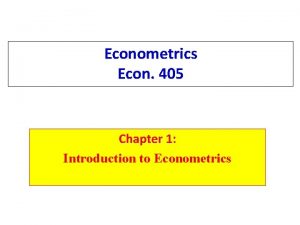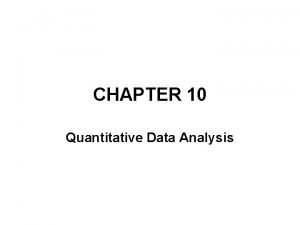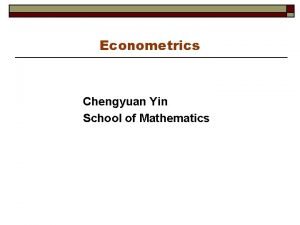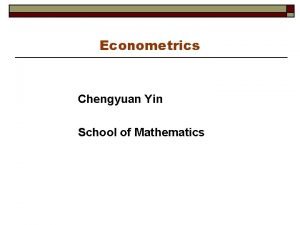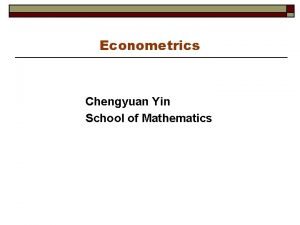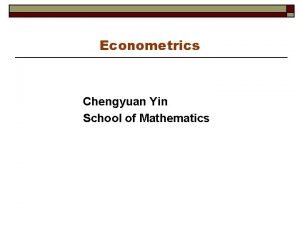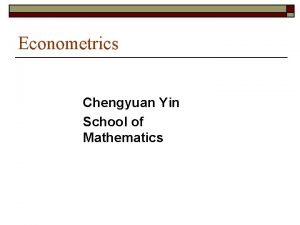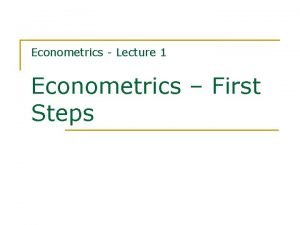Introduction to Econometrics and Quantitative Research The Statistical












































- Slides: 44

Introduction to Econometrics and Quantitative Research The Statistical Analysis of Economic (and related) Data 1

Lecturer Dr. Mohammed I. Migdad Associate Prof. In Economics I. U. Gaza &Institute for Development Studies (IDS) 2

Brief Overview of the Course • This course includes definition and importance of studying the economic variables, types and ways of analyzing quantitative economic data. Differences between research methodology and econometric research. 3

continue • It includes also types of economic models, correlation, linear and nonlinear regression both simple and multiple. It also study econometrics problem facing simple and multiple regression. 4


Teaching methods Lecturing using LCD and the board. 2. Student presentation for topics 3. Case study including data collection and analysis and discussing results. 4. Home work 1. 6

Outputs: • We aim to enable students to analyze the economic data in deep, depending on econometric models using SPSS program, • as well as to defense their research and analysis results among group of students. 7

evaluation • Final exam 50% • Case study, discussion & home work 50% 8

Course teaching plan First : Definition, importance and research methodology Second: Types of economic data Third : Stages of economic research 9

continue 4. Descriptive analysis and correlation 5. Discussing the case study for each student 6. Types of equations using SPSS 7. Simple regression model 8. applications 10

continue 9. Multiple regression model 10. Applications 11. Regression with dummy variables 12. Econometrics problems 1 13. Econometrics problems 2 11

continue 14. Logistic regression model 15. Discussing results of the case study including interpretation of results 16. Continue discussing results and interpretation 12

Brief Overview of the Course • Economics suggests important relationships, often with policy implications, but virtually never suggests quantitative magnitudes of causal effects. • What is the quantitative effect of reducing class size on student achievement? • How does another year of education change earnings? 13

continue • What is the price elasticity of cigarettes? • What is the effect on output growth of a 1% point increase in interest rates ? • What is the effect on housing prices of environmental improvements? 14

From Wikipedia Econometrics the free encyclopedia • Econometrics is concerned with the tasks of developing and applying quantitative or statistical methods to the study and elucidation of economic principles and economic problems. 15

Econometrics • Econometrics combines economic theory with statistics to analyze and test economic relationships, hypothesis and to study economic problems. 16

Theory & Application • Theoretical econometrics considers questions about the statistical properties of estimators and tests , • while applied econometrics is concerned with the application of econometric methods to assess economic theories. 17

The start of econometrics • Although the first know of the term “econometrics” was use by Pawel Coimpa in 1910. • Ranger Frisch is given credit for coining the tern in the since that it is used today.

19

definition • Econometrics literally means 'economic measurement'. It is a combination of mathematical economics, statistics, economic statistics and economic theory. 20

Definition of Econometrics • econometrics, technique of economic analysis that expresses economic theory in terms of mathematical relationships, and then tests it empirically through statistical research. • Econometrics attempts to develop accurate economic forecasting and to make possible successful policy planning. 21

Con. • The term econometrics is generally attributed to Norwegian economist Ragnar Frisch, who wrote important studies on the subject in the mid-20 th cent. and founded the Econometric Society. 22

continue • In the 1930 s econometrics emerged as an important method of economic study on a national level, as part of a broad, new field called macroeconomics. • In the 1950 s economists such as Lawrence Klein applied Keynesian principles to econometrics and formed macroeconometric models of the economy of the United States. 23

continue • Scholars, economists, and public officials soon followed Klein's lead and began to use large-scale econometric models in both historical and planning analyses.

definitions • the application of mathematics and statistics to the study of economic and financial data. • and Econometrician is Someone who studies economies with a view to mathematics 25

Defin. • econometric - Combining economics and mathematics. • The application of statistical theories to economic ones for the purpose of forecasting future trends. • A branch of statistics that deals with the time series data common in economics and finance. . more on Econometrics. 26

Defin. • The analysis of economic systems containing supply and demand data using statistical models. • Mathematical computerized models used to illustrate the relationship between key economic conditions such as employment rates, interest rates, and between GDP and factors affecting it. 27

Application of Ecotrics • econometric - methods are applied in economics, finance, marketing , criminology, operations research, climatology, geography, psychology , medicine 28

Importance of Econometrics 1. To examine the statistical and economic hypothesis. 2. To provide a statistical method to analyze the economic data rather than the traditional descriptive method. 29

importance 3. It help in drawing and implementing the economic policies 4. Econometrics helps in using the scientific research in forecasting. 30

Importance 5. It make the use of computer in analyzing data is easy, especially to find relation between more than 3 variables. 6. It help to find exact numeric results depending on deep analysis. 31

Objectives of Econometrics Econometric research has different objectives: 1. Establishing applied economic models, in a testable and realistic form. 2. To chose the best alternative among theories that is suitable to the case.

Objectives 3. Test and estimate economic models using empirical data to estimate constant (estimators) of the equation and calculate variables. 4. It helps in using models in forecasting and policy implications. 33

What are Models • A statistical model is a set of mathematical equations which describe the behavior of an object of study in terms of random variables and their associated probability distributions. 34

. Cont • If the model has only one equation it is called a single-equation model, whereas if it has more than one equation, it is known as a multipleequation model.

Simple Models • Many scientists have argued in favor of simplicity, because simple models is easier to understand, communicate and test empirically with data. This is the position of Milton friedman and karl popper.

S. Models The choice of a simple model to explain the complex realworld phenomena leads to two criticisms: 1. The model is over simplified. 2. The assumptions are unrealistic.

Quantitative analysis • Quantitative analysis id the use of numbers and equations in analyzing social sciences. • It use equations to find the relations between dependant and independent variables to test different hypothesis.

Econometrics and research • We consider econometrics as the quantitative research methodology in economics and other sciences using numeric data and equations. • So econometrics is a scientific quantitative deep research and analysis.

Deep analysis • Is a type of analysis that use numeric data and models in analyzing economic phenomena. • It is not a descriptive or qualitative analysis but a quantitative one

Quantitative and qualitative research • In economic problems, economists traditionally used the qualitative research due to the nature of the economic issues. • But later on, and after the econometrics society foundation, they start to use quantitative methods in analyzing economic problems.

quantitative research and economics • Do you thing quantitative research is suitable for economic and social science? • Or the descriptive analysis is more suitable?

? Why • We accept that the deep quantitative analysis is very important and suitable for the social and economic sciences? • That’s because it use numeric and empirical data and can test theories & hypothesis, and it is a good forecasting method.

 Econometrics and quantitative economics
Econometrics and quantitative economics Lesson 1 quantitative research design
Lesson 1 quantitative research design Quantitative observation
Quantitative observation Introduction to econometrics for finance
Introduction to econometrics for finance Is interviews qualitative or quantitative
Is interviews qualitative or quantitative Application forms qualitative or quantitative
Application forms qualitative or quantitative Similarities between qualitative and quantitative research
Similarities between qualitative and quantitative research Similarities between qualitative and quantitative research
Similarities between qualitative and quantitative research Sampling methods in qualitative and quantitative research
Sampling methods in qualitative and quantitative research Purpose of qualitative research
Purpose of qualitative research Mixed methods research examples
Mixed methods research examples Methodology triangulation
Methodology triangulation Nature and scope of managerial economics
Nature and scope of managerial economics Sample regression function
Sample regression function Applied econometrics dimitrios asteriou pdf
Applied econometrics dimitrios asteriou pdf Statistical control in research
Statistical control in research Montgomery quality control
Montgomery quality control Introduction to quantum statistical mechanics
Introduction to quantum statistical mechanics Introduction to statistical quality control
Introduction to statistical quality control Holistic account in research
Holistic account in research Sample of appendices in research paper
Sample of appendices in research paper Descriptive correlational research design
Descriptive correlational research design Example of descriptive research
Example of descriptive research Quantitative research design example
Quantitative research design example Is descriptive correlational design quantitative
Is descriptive correlational design quantitative The two kinds of quantitative research are
The two kinds of quantitative research are Research process flowchart
Research process flowchart Data types in quantitative research
Data types in quantitative research Research chapter 3 parts
Research chapter 3 parts Key concepts of qualitative research
Key concepts of qualitative research Independent variable in research
Independent variable in research T test quantitative research
T test quantitative research What is the sample size in qualitative research?
What is the sample size in qualitative research? Quantitative research about cycling
Quantitative research about cycling Theoretical framework and hypothesis development
Theoretical framework and hypothesis development Types of methodologies
Types of methodologies Grand tour questions qualitative research
Grand tour questions qualitative research Conceptual phase of quantitative research
Conceptual phase of quantitative research Research designs meaning
Research designs meaning Example of the scope and limitation of the study
Example of the scope and limitation of the study Non-experimental quantitative research
Non-experimental quantitative research Characteristics of experimental research design
Characteristics of experimental research design How to make hypothesis in quantitative research
How to make hypothesis in quantitative research Research design
Research design Strength and weaknesses of qualitative research
Strength and weaknesses of qualitative research
